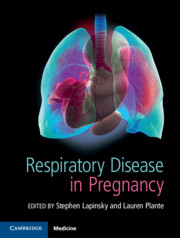Book contents
- Respiratory Disease in Pregnancy
- Respiratory Disease in Pregnancy
- Copyright page
- Contents
- Contributors
- Section 1 The Basics: for the Obstetrician
- Section 2 The Basics: for the Non-Obstetrician
- Section 3 Pulmonary Conditions Not Specific to Pregnancy
- Section 4 Pulmonary Conditions Related to Pregnancy
- Section 5 Other Pulmonary Issues in Pregnancy
- 19 Tobacco Smoking in Pregnancy
- 20 Radiological Imaging of the Chest in Pregnancy
- 21 Respiratory Drug Therapy in Pregnancy
- 22 Biological and Immunosuppressive Respiratory Therapy in Pregnancy
- 23 Oxygen Therapy during Pregnancy
- 24 Airway Management in Pregnancy
- 25 Mechanical Ventilation in Pregnancy
- Index
- References
25 - Mechanical Ventilation in Pregnancy
from Section 5 - Other Pulmonary Issues in Pregnancy
Published online by Cambridge University Press: 14 April 2020
- Respiratory Disease in Pregnancy
- Respiratory Disease in Pregnancy
- Copyright page
- Contents
- Contributors
- Section 1 The Basics: for the Obstetrician
- Section 2 The Basics: for the Non-Obstetrician
- Section 3 Pulmonary Conditions Not Specific to Pregnancy
- Section 4 Pulmonary Conditions Related to Pregnancy
- Section 5 Other Pulmonary Issues in Pregnancy
- 19 Tobacco Smoking in Pregnancy
- 20 Radiological Imaging of the Chest in Pregnancy
- 21 Respiratory Drug Therapy in Pregnancy
- 22 Biological and Immunosuppressive Respiratory Therapy in Pregnancy
- 23 Oxygen Therapy during Pregnancy
- 24 Airway Management in Pregnancy
- 25 Mechanical Ventilation in Pregnancy
- Index
- References
Summary
Respiratory failure is an uncommon complication of pregnancy, affecting only 0.1% of pregnant women; however, it is one of the main indications for intensive care unit (ICU) admission of pregnant and peri-partum women. Pregnancy is a unique physiologic state in women’s lives, and physicians should be familiar with it. Given the low incidence of respiratory failure during pregnancy, there is limited scientific evidence about the best strategies for this population.
- Type
- Chapter
- Information
- Respiratory Disease in Pregnancy , pp. 233 - 244Publisher: Cambridge University PressPrint publication year: 2020
References
- 1
- Cited by

